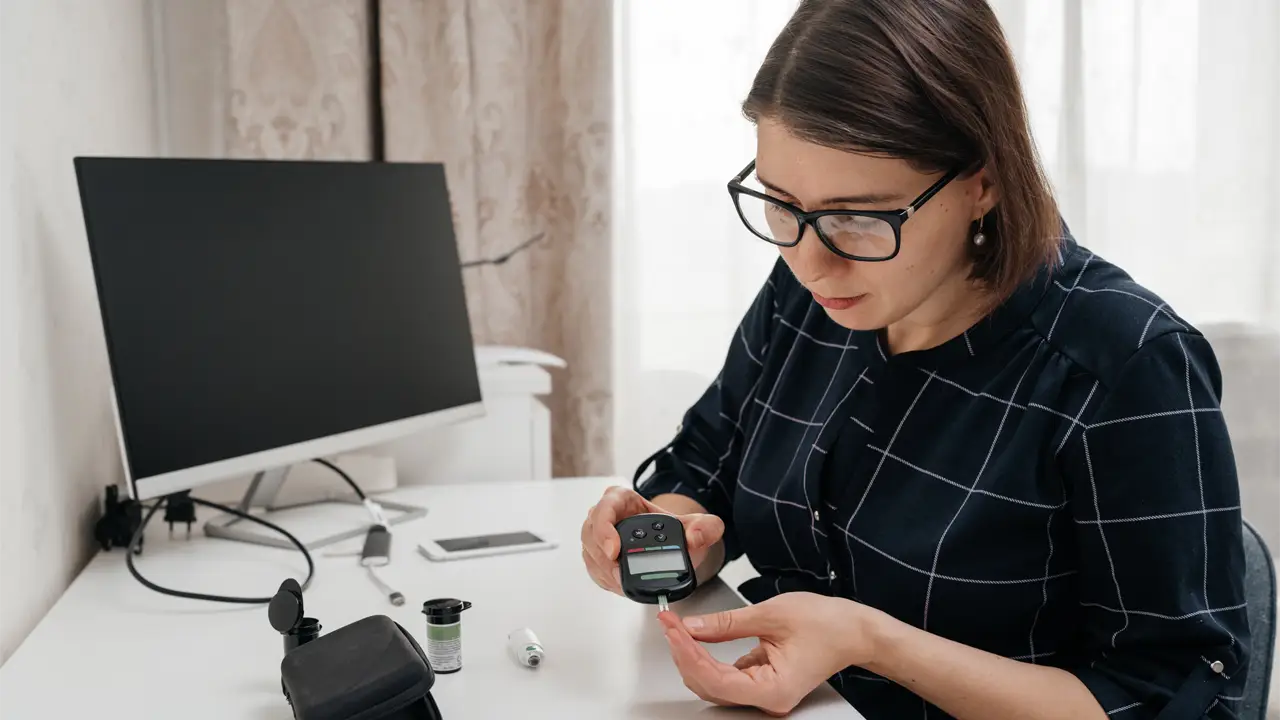Maintaining optimal blood sugar levels according to age is pivotal for overall well-being, particularly for individuals susceptible to diabetes. Elevated blood sugar levels pose significant risks, including cardiovascular disease, kidney impairment, and nerve damage, while low levels can precipitate seizures or loss of consciousness.
In this blog, we delve into the significance of identifying target blood sugar levels corresponding to age and offer a comprehensive chart for reference. We also explore the role of remote patient monitoring in facilitating regular tracking of blood glucose levels, allowing for timely interventions and personalized healthcare management. By comprehending the importance of monitoring blood glucose levels, you can proactively manage your health and avert potential health issues down the road.
Importance of Monitoring Blood Sugar Levels of People with Diabetes
Monitoring blood sugar levels is important for maintaining overall health, especially for those with diabetes. Blood sugar level refers to the amount of glucose present in the blood at any given time. Glucose is a simple sugar that’s always present in the blood, and it’s the body’s primary source of energy.
Fasting blood sugar levels of 99 mg/dL or less are considered normal, 100 mg/dL to 125 mg/dL are considered to be prediabetic levels, and 126 mg/dL or above are considered to be diabetes levels. However, these levels may vary depending on factors such as age, activity level, and overall health. A normal blood sugar levels chart can help to determine the appropriate range for an individual based on their age.
Connection between Blood Sugar Levels and Overall Health
There are normal blood sugar levels by age, and it’s important to understand the normal range for blood sugar level to assess a healthy target blood sugar level. The American Diabetes Association provides a normal blood sugar levels chart, which can be used to check your blood sugar and monitor your levels within the recommended range.
Low blood sugar levels, also known as hypoglycemia, can cause symptoms such as shakiness, dizziness, and confusion. High blood sugar levels, or hyperglycemia, can cause symptoms such as frequent urination, increased thirst, and fatigue.
Type 1 diabetes and type 2 diabetes are conditions that affect blood sugar levels, and individuals with these conditions may have low blood sugar or high blood sugar. Fasting blood sugar, fasting glucose level, and random blood sugar tests are used to measure blood sugar levels and assess a measure of blood sugar control.
Maintaining healthy blood glucose levels can lead to better overall health and reduce the risk of complications associated with diabetes. Factors such as your age, family history of diabetes, and lifestyle choices impact blood sugar levels. It’s recommended to manage your blood sugar through diet, exercise, and medication if necessary to keep your blood sugar levels in a healthy range.
How to Interpret High Blood Sugar and Low Blood Sugar Levels
A chart of normal blood sugar levels by age can be used to determine a healthy blood sugar level for different age groups. People without diabetes should aim to maintain a healthy blood sugar level to prevent the onset of type 2 diabetes.
High blood sugar levels, also known as hyperglycemia, occur when the blood sugar level exceeds the normal range. People with type 1 or type 2 diabetes may experience high blood sugar levels due to inadequate insulin production or resistance to insulin. Symptoms of high blood sugar levels include increased thirst, frequent urination, blurred vision, and fatigue.
Low blood sugar levels, also known as hypoglycemia, occur when the blood sugar level drops below the normal range. This can be caused by skipping meals, too much exercise, or taking too much insulin. Symptoms of low blood sugar levels include shakiness, confusion, sweating, and rapid heartbeat.
Definition of Blood Sugar Level
Blood sugar level refers to the amount of glucose or sugar present in the bloodstream at a given time. Glucose is a crucial source of energy for the body, and the level of glucose in the blood is tightly regulated by the body’s hormonal system. When we consume carbohydrates, they are broken down into glucose, which is then absorbed into the bloodstream. In response to this increase in blood glucose levels, the hormone insulin is released from the pancreas to help move glucose from the blood into cells where it can be used for energy or stored for later use. Conversely, when blood glucose levels fall, the hormone glucagon is released to stimulate the liver to release stored glucose into the bloodstream to maintain normal blood glucose levels. Understanding and monitoring your blood sugar level is important for maintaining overall health, particularly for people with diabetes or those at risk of developing diabetes.
How Blood Glucose Levels Are Measured
Blood sugar levels are typically measured by a blood glucose test, which can be done using a glucose meter or through a lab test. Glucose meters are portable devices that use a small amount of blood, typically taken from the fingertip, to measure blood sugar levels. This type of test is commonly used by people with diabetes to monitor their blood sugar levels at home.
Lab tests, on the other hand, are usually performed at a doctor’s office or laboratory. They may involve drawing blood from a vein in the arm or a finger prick, and the blood sample is then analyzed to determine the blood glucose level.
The Importance of Knowing Your Target Blood Sugar Levels Based on Your Age
It is crucial to know your target blood sugar levels based on your age, especially if you have diabetes. As our bodies age, they may become less effective at regulating blood sugar levels, which can lead to various health problems. Working with healthcare providers to determine individualized targets and developing a plan for monitoring and managing blood sugar levels can reduce the risk of complications and improve overall health and quality of life. Blood sugar targets can vary based on age, health status, and other factors. Regular blood sugar tests, lifestyle changes, and medication may be necessary to maintain healthy blood sugar levels.
Chart of Normal Blood Sugar Levels by Age for Adults
The following chart outlines the normal blood sugar levels for adults based on age and time of day. It is important to note that individual target blood sugar levels may vary based on personal health conditions and recommendations from healthcare providers.
| Age | Fasting blood sugar level | After meals blood sugar level |
|---|---|---|
| 18 – 50 | 70 – 99 mg/dL | 70 – 140 mg/dL |
| 51 – 60 | 70 – 105 mg/dL | 70 – 150 mg/dL |
| 61 – 90 | 70 – 115 mg/dL | 70- 160 mg/dL |
It is important to regularly monitor blood sugar levels and consult with a healthcare provider if levels consistently fall outside of the normal range. Maintaining healthy blood sugar levels is crucial for overall health and can help prevent the onset of chronic conditions such as diabetes and heart disease.
Understanding the Blood Sugar Test
The blood sugar test is a diagnostic tool used to measure the concentration of glucose in the blood. This test is crucial for people with diabetes, but it can also be used to diagnose other conditions that affect blood sugar levels. The test can be done by a healthcare professional in a clinic or hospital setting, or at home using a blood glucose meter.
Normal Range for Blood Sugar Level
The normal range for blood sugar level depends on several factors, including age, time of day, and whether the person has eaten recently. Generally, the normal range for fasting blood sugar is between 70 and 99 mg/dL, while the normal range for blood sugar two hours after eating is less than 140 mg/dL. However, these ranges may vary depending on the individual’s health status and other factors.
The Role of Diet and Exercise in Maintaining Normal Blood Sugar Levels
Maintaining a healthy diet and engaging in regular exercise are essential components of diabetes management and prevention. Diet influences blood sugar levels directly, as certain foods can cause rapid spikes or drops in blood glucose levels. On the other hand, exercise helps the body utilize glucose for energy, which can lead to improved blood sugar control over time.
Balanced diet: Opt for a balanced diet with fiber, whole grains, fruits, veggies, lean proteins, and healthy fats. Limit refined carbs, sugary drinks, and processed foods. Manage portion sizes and evenly distribute carbohydrate intake to prevent blood sugar spikes.
Regular exercise: Engage in 150 minutes of moderate-intensity aerobic exercise or 75 minutes of vigorous-intensity exercise weekly, alongside strength training twice a week to improve insulin sensitivity. Opt for enjoyable activities like walking, cycling, swimming, or dancing to maintain a sustainable exercise routine.
Monitoring and adjusting: Monitor blood sugar levels before and after meals and exercise to assess their impact on glucose levels. Collaborate with a registered dietitian or diabetes educator to create a personalized meal plan and make informed food choices for blood sugar control. Consult a healthcare provider before beginning a new exercise routine, particularly if you have health conditions or take medications affecting blood sugar levels.
The Importance of Remote Patient Monitoring for Blood Sugar Monitoring
Remote patient monitoring (RPM) has become an effective method for managing blood sugar levels in people with diabetes. RPM involves the use of technology to monitor and collect data on blood sugar levels, which can then be remotely analyzed by healthcare professionals. This approach offers numerous benefits, including improved access to care, more frequent monitoring, and early detection of changes in blood sugar levels.
RPM for blood sugar level monitoring is especially important for people with type 1 and type 2 diabetes. By monitoring blood sugar levels regularly, healthcare providers can adjust medication and lifestyle recommendations to keep blood sugar levels within a healthy range. This is critical because high or low blood sugar levels can lead to a range of health complications.
One of the key advantages of RPM is that it allows for regular monitoring of blood sugar levels without requiring patients to visit a healthcare provider in person. This is especially important for older adults or those with mobility issues. RPM also enables patients to track their blood sugar levels more frequently, providing more accurate data that can help identify patterns and trends in blood sugar levels over time.
Frequently Asked Questions
Why is it important to know normal blood sugar levels by age?
Understanding normal blood sugar levels by age helps individuals monitor their health and detect any deviations from the expected range, which can indicate potential health issues such as diabetes or pre-diabetes.
What are the potential health risks associated with high blood sugar levels?
High blood sugar levels can lead to serious health complications over time, including cardiovascular disease, kidney damage, nerve damage, and an increased risk of developing diabetes-related complications.
What are the dangers of having low blood sugar levels?
Low blood sugar levels can cause symptoms such as dizziness, confusion, sweating, and in severe cases, loss of consciousness or seizures. It is important to be aware of these symptoms and take appropriate actions to raise blood sugar levels if necessary.
How can I maintain normal blood sugar levels through diet and exercise?
Consuming a balanced diet rich in fiber, whole grains, fruits, vegetables, lean proteins, and healthy fats, while limiting refined carbohydrates and sugary foods, can help regulate blood sugar levels. Regular physical activity, including aerobic exercise and strength training, also contributes to better blood sugar control.
What role does remote patient monitoring play in blood sugar management?
Remote patient monitoring allows individuals to track their blood sugar levels regularly from the comfort of their homes using wearable devices or mobile apps. This facilitates timely interventions and personalized healthcare management, helping individuals maintain optimal blood sugar levels and prevent complications.
DrKumo Remote Patient Monitoring
DrKumo is a leading provider of secured remote patient monitoring technology solutions for the healthcare industry. Our state-of-the-art, HIPAA-compliant, mobile-enabled, continuous real-time monitoring, and AI/ML engine-powered solutions enable healthcare providers to remotely monitor the health conditions of their patients at home, while also providing patients with the ability to manage their health conditions in the comfort of their own homes.
Takeaway
RPM technology benefits people with diabetes by monitoring blood sugar levels, providing feedback, and allowing real-time communication with healthcare providers. Tools like glucose meters, continuous glucose monitors, and mobile apps enable easy tracking and data sharing. RPM remotely monitors patients, detects trends, identifies health concerns, and offers personalized support, leading to better blood sugar control, reduced complications, and flexible treatment plans.
DrKumo offers a highly scalable and innovative RPM solution that fosters collaboration and technology-driven culture, improving care quality and reducing costs associated with frequent visits and hospital stays.
Consider utilizing rpm technology to monitor blood sugar levels, receive real-time feedback, and communicate with healthcare providers. Contact us today!








